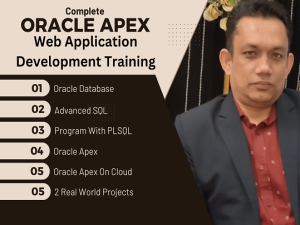Oracle SQL Masterclass : Advanced Skills for Software Developers
Introduction
3
Join the secret Facebook group
4
Join the Secret Whatsapp Group
Installation
2
Enable Pluggable Database with TNSNAMES.ORA file
3
How To Create [TNS Service] Using Oracle Net Configuration Assistant
4
UNLOCK HR AND SCOTT USER
5
Introduction to SQL Plus
6
Introduction to SQL Developer with Installation
Query : Common SQL*PLUS commands
1
Common SQL*PLUS commands
Query : Sorting Data
1
Order By Clause
2
Sorting by Column Aliase
3
Sorting by Multiple Columns
Query : Writing Basic SQL Statements
1
Selecting Columns
2
Using the Concatenation Operators
3
Using Arithmetic Operators
4
Defining Null Values
5
Using Column Aliases
6
Using the Concatenation Operators
7
Eliminitating Duplicate Rows
Query : Single Row Functions
1
Case-manipulation functions
2
Character-manipulation functions
3
Number Functions
4
Date Functions
5
Using the TO_CHAR functions with Dates
6
Using the TO_CHAR functions with Numbers
7
RRRR Format
8
Nesting Functions
9
Using the NVL Functions
10
Using the DECODE Functions
Query : Restricting Data
1
Using the Where Clause
3
Comparison Conditions
4
Logical Conditions – Using the AND, OR, NOT Operators
5
Using the Between Conditions
6
Using the IN Comparison Conditions
7
Using the Like Conditions
9
Logical Conditions – Using the AND, OR, NOT Operators
Query : Displaying Data from Multiple Tables
1
Cartesian-Products
2
Non-Equi-Joins
3
Equi-Joins
4
Self Joins
5
Non-Equi-Joins
6
Outer Joins
7
Self Joins
Query : Sorting Data
1
Order By Clause
2
Sorting by Column Aliase
3
Sorting by Multiple Columns
Query : Aggregating Data Using Group Functions
1
Types of Group Functions
2
Using the Group By Clause
3
Illegal Queries using group functions
4
Using the HAVING clause
5
Nesting Groups
Query : Single Row Functions
1
Case-manipulation functions
2
Character-manipulation functions
3
Number Functions
4
Date Functions
5
Using the TO_CHAR functions with Dates
6
Using the TO_CHAR functions with Numbers
7
RRRR Format
8
Nesting Functions
9
Using the NVL Functions
10
Using the DECODE Functions
Query : Subqueries
1
Using the SUBQUERIES
2
Executing Single Row Subqueries
3
Using Group Function in a Subqueries
4
The Having Clause with Subqueries
5
Using the ANY operator in multiple row subqueries
6
Using the ALL operator in multiple row subqueries
7
Null Values in a Subquery
Query : Aggregating Data Using Group Functions
1
Types of Group Functions
2
Using the Group By Clause
3
Illegal Queries using group functions
4
Using the HAVING clause
5
Nesting Groups
DDL : Creating and Managing Views
1
Creating and Managing Views
DDL : Creating and Managing Tables
1
Creating and Managing Tables
2
Quering the Data Dictionary Table
3
Creating a Table by Using a Subquery
4
Adding, Modifying and dropping a column
5
The Set Unused Option
6
Changing the name of an Object
7
Dropping a Table
8
Truncating A Table
Data Manipulation Language (DML)
1
Manipulating Data – Insert
2
Manipulating Data – Update
3
Manipulating Data – Delete
4
Manipulating Data – Merge
Data Definition Language (DDL) : Including Constraints
1
Including Constraints – Not Null
2
Including Constraints – Primary Key
4
Including Constraints – Unique Key
5
Including Constraints – Check
Data Control Language (DCL)
1
Controlling User Access
Transaction Control
1
Data Control with Rollback and Commit
2
Data Update on Different Sessions
DDL : Creating and Managing Views
1
Creating and Managing Views
Data Manipulation Language (DML)
1
Manipulating Data – Insert
2
Manipulating Data – Update
3
Manipulating Data – Delete
4
Manipulating Data – Merge
Other Database Objects
1
Other Database Objects – Sequence
2
Other Database Objects – Index
3
Other Database Objects – Synonym
Quiz and Free E-books
1
Oracle SQL Quiz
2
E-books
Bonus Lecture
1
Bonus - The UNION [ALL], INTERSECT, MINUS Operators
2
Top-N-Analysys
3
If Condition in SQL : Case
What is Next ?
1
Learn PLSQL to move forward.





